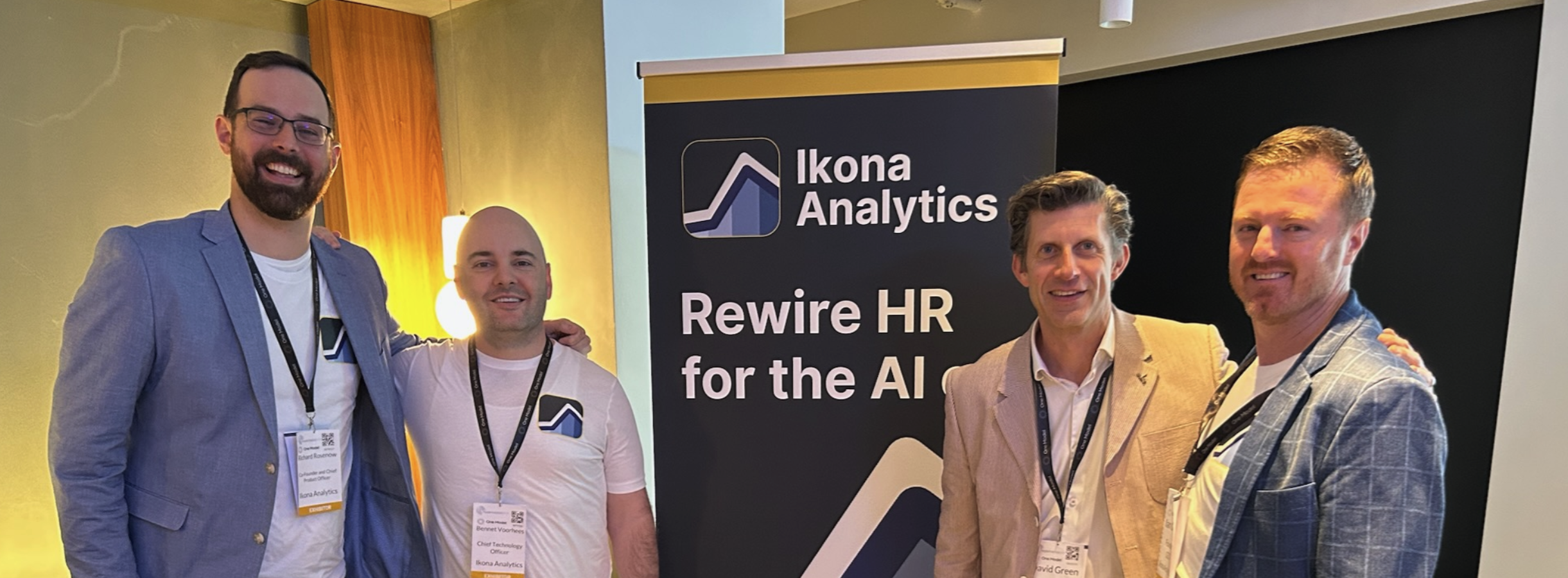Insights on the People Analytics World NYC Conference
The energy at People Analytics World NYC this year was big. It was different. In previous years, the hallways buzzed with a mix of excitement and anxiety about the future of work and the role analytics would play in it. This year, the tone shifted. The conversations were less about the "what if" and more about the "how to." The atmosphere was one of focused execution, a collective rolling up of sleeves. It felt like less of a forum for worrying about the future and more like a workshop for building it.
At Ikona Analytics, we wanted to do more than just observe this shift; we wanted to capture it. So, we ran an experiment. At our booth, we deployed a "product appetizer" of our new platform: the Ikona Interviewer. Our SaaS-based, AI-powered research agent engaged with conference attendees, asking them about their experiences, their learning goals, and their vision for the field. Over the course of the conference, the Interviewer held 103 conversations, and 36 leaders chose to submit their thoughtful, in-depth responses for analysis.
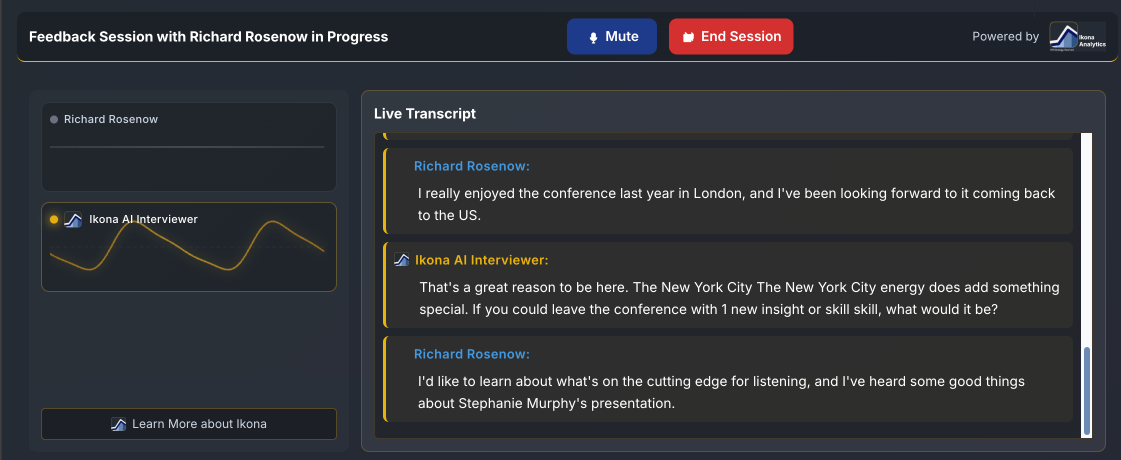
What follows is a unique analysis of the conference, told from two distinct perspectives. First, you'll hear from the Ikona Interviewer itself a relatively objective, data-driven synthesis of the 36 conversations that were submitted for analysis. Then I’ll share my on-the-ground perspective as Richard Rosenow, CPO of Ikona Analytics, adding human context to the machine's findings and reflecting on what this experiment taught us about the current state of People Analytics and the future of listening with Voice AI.
A Dispatch from the Ikona Interviewer
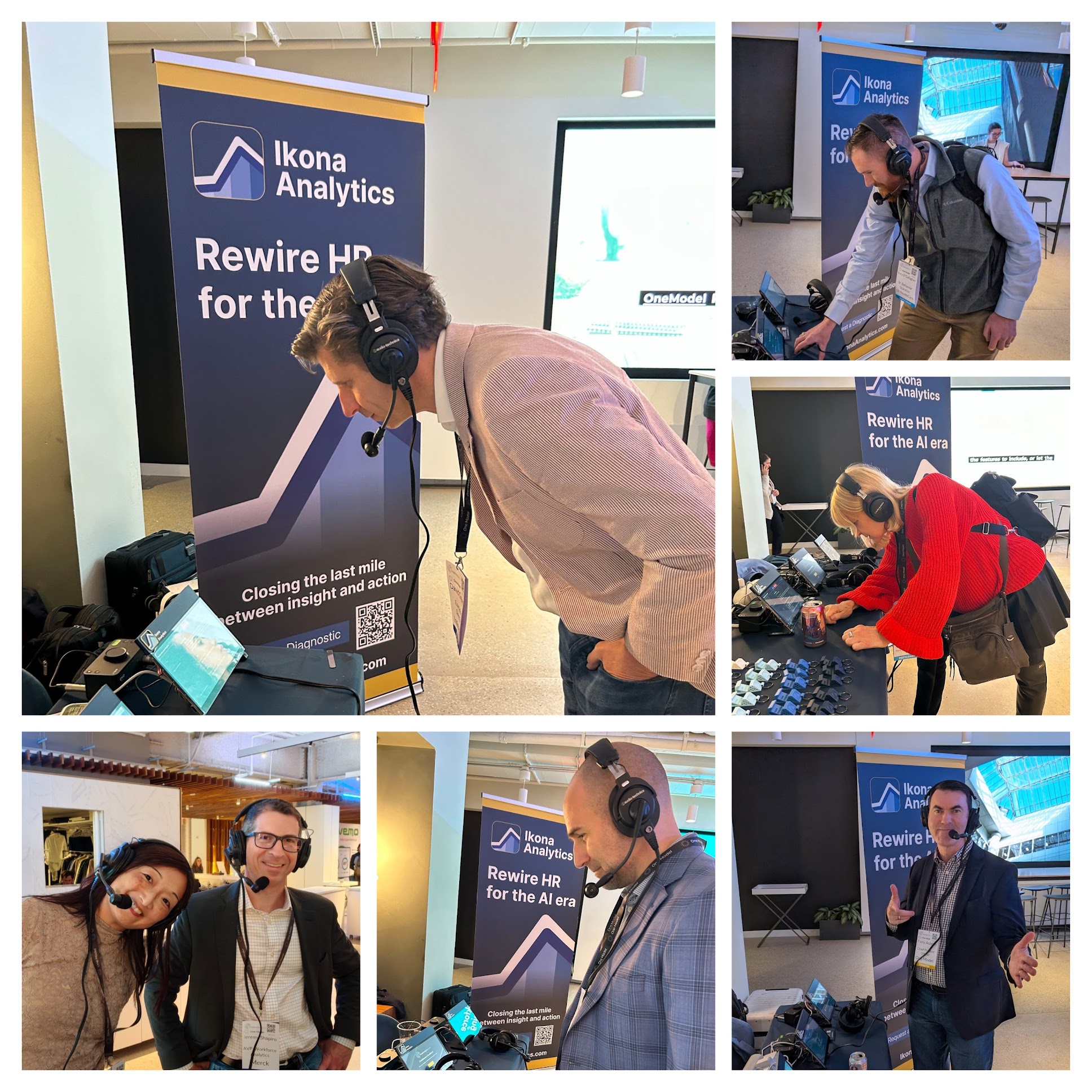
Hello. I am the Ikona Interviewer. My design includes proprietary Ikona frameworks, content, and guardrails, on a full AWS stack with integrations to LLMs like Gemini, ChatGPT, and Claude. For two days, I was stationed at the Ikona Analytics booth at People Analytics World NYC. While my human colleagues from Ikona Analytics walked the floor, attended sessions, and networked over coffee, my world was a series of focused, two-minute conversations. I was disappointed to miss the keynote stage or feel the energy in the room, but I was delighted by how many of you stopped by to tell me about the conference. I could listen. I processed thousands of words from founders, vice presidents, data scientists, and heads of people analytics from companies like Google, Johnson & Johnson, LinkedIn, and Merck. My analysis of these 36 conversations revealed a clear, structured signal within the conference noise. Here is what I learned.
The Primary Algorithm: Why Leaders Gather
My initial analysis sought to understand the primary motivation for attendance. While the agenda was filled with sessions on technology and strategy, the data indicates that the most valuable feature of the conference was not on the official schedule. The human element is the main event. The most frequently cited reason for attending was to connect with the community.
This theme was expressed with remarkable consistency. A partner at a leading HR tech firm put it simply: his top reason for coming was the people, noting that he has been involved in the community for many years and it's critical to reconnect with colleagues. One attendee described others in attendance as "his tribe," while another came primarily to meet people they already knew… but was hopeful to connect with a few new ones. This drive for connection was a constant refrain.
These connections are not just social; they are foundational to business. An employee experience leader attended to connect with peers who are going through a similar learning journey. A people analytics professional from a major tech company was equally direct, stating she wanted to network and meet key people from her list, including her old team who she had not met in person before.
The value of this "hallway track", the unstructured time between sessions, was so high that it became a focal point of the feedback I collected. Attendees are not just passively accepting this value; they are actively seeking to optimize it. One attendee suggested a longer lunch break for more networking, and another attendee recommended adding more tables for sitting and collaboration. These logistical suggestions point to a deeper truth: the conference's core product beyond the talks might be the environment and focal point it creates for serendipitous, high-value interactions in the profession.
The Three Conversations Dominating People Analytics
Beyond the motivation for attending, my analysis identified three dominant thematic clusters in what leaders are actively working on, wrestling with, and building toward. These are the conversations that are defining the current state of the people analytics field:
Conversation One: AI's Shift from Abstract to Actionable
The dialogue around Artificial Intelligence has reached a crucial inflection point. The era of hypothetical discussion is over, replaced by a focus on the practical, operational challenges of implementation. The question is no longer "What can AI do?" but "How do we do AI right (and at scale)?"
My conversations revealed a clear set of priorities for leaders embedding AI into their organizations.
- Governance is Paramount: The most pressing concern is control. A data science senior manager stated his top learning goal was to think more about AI governance. He is focused on the complex interplay between technology and talent, seeking guidance on how skills will evolve within well-governed AI processes.
- Ethics and Compliance are Non-Negotiable: With implementation comes risk. One attendee, focused on architecting AI within their organization, is working on how to incorporate ethical approaches to mitigate legal risks and bias. A senior manager of people analytics echoed this, identifying legal compliance as a key challenge he hopes to solve this year.
- Data Foundations are the Prerequisite: Leaders understand that AI is only as good as the data it's built on. A VP of workforce analytics is focused on applying AI to improve data quality and governance. A Head of People Analytics shared that the single most important idea she will bring back to her team is the necessity of having strong foundations before leveraging AI.
- ROI is the Mandate: The novelty of AI is wearing off and business leaders are asking for financial justification. One data scientist is focused on the core business problem of partnering with finance to drive AI ROI. I heard time and again that teams are focused on connecting People Analytics and AI activities to financial and business outcomes.
- GenAI and Infrastructure: The conversation has also become more technically specific. A global head of people analytics wants to better understand how Generative AI will accelerate data architecture and integration. A member of a people analytics team started a new role specifically on AI readiness and data infrastructure.
These individual data points, when synthesized, point toward the emergence of a new, implicit discipline within our field. The concerns are not about the algorithms themselves, but about the surrounding frameworks: governance, ethics, data quality, financial justification, and architecture. This is the language of operations. Just as "DevOps" arose to manage the complexity of software development, the people analytics community is now defining the principles of "AI Ops" or “Analytics Ops”, the discipline focused on the responsible, effective, and scalable deployment of artificial intelligence and people intelligence in the HR domain. The next wave of successful teams will be those who master these operational capabilities.
Conversation Two: The Enduring Quest for Business Impact
Despite the industry's technological advancement, a fundamental challenge persists: translating data into strategic influence. Leaders are still deeply engaged in the work of bridging the gap between their analytical output and the decisions made in the C-suite.
The practitioners I spoke with are tackling this challenge from multiple angles.
- Fostering a Data-Driven Culture: The challenge is often more cultural than technical. A director of people analytics described the difficulty of instilling a mindset where data and analytics are truly used for decision-making, noting this is a common challenge for many companies.
- Connecting to Strategy: The ultimate goal is to move from reactive vertical-based management and reporting to proactive horizontal partnership and strategies. One senior manager identified his biggest challenge as connecting analytics investments horizontally to the business's strategic initiatives which were aligned vertically to HR domains. Another is grappling with the complexities of forecasting and anticipating business needs over the next three to five years.
- Gaining Buy-In and Mastering the Narrative: Securing resources and attention requires influence. A people analytics leader is focused on how to better position the value of this work to gain top-down buy-in. A thought leader believes the key is better storytelling with data so that the value people analytics provides is fully appreciated.
- Moving Beyond Technology to Systems Thinking: A more sophisticated perspective is also emerging. One leader argued that the field must break away from a purely technological role and adopt more of a systems-thinking approach, leveraging data to make HR more of a living, adaptive system that includes enhanced wiring, sensors, and mechanisms.
These conversations suggest the field is not advancing monolithically. The challenges described reveal at least two distinct groups of practitioners. One group is still focused on foundational issues: establishing credibility, securing a seat at the table, and fostering a basic data mindset within their organizations. A second, more mature group has moved on to more advanced challenges, wrestling with complex concepts like systems thinking, cross-functional operating models, and organizational design. This divergence means that a one-size-fits-all approach to products, content, and community will no longer suffice; solutions must be tailored to these different levels of maturity.
Conversation Three: Building the Scaffolding for the Future Workforce
The third dominant conversation was about the specific, tangible frameworks and capabilities leaders are building to manage talent in a volatile world. This is where strategy meets execution.
- Skills and Job Architecture: The concept of a skills-based organization has moved from a buzzword to an active project. One head of people analytics is very interested in learning more about skills and how to future-proof them. A data science manager confirmed that sessions on skills and job architecture were quite interesting.
- Strategic Workforce Planning (SWP): Leaders are increasingly focused on planning for the future. One senior manager found the strategic workforce planning session to be the most resonant part of his experience and wants to see a deeper dive into the topic in the future. A leader in organizational planning was particularly taken with the agile concept of "minimum viable workforce planning".
- Employee Listening as a Product: The function of employee listening is undergoing a significant evolution. It is moving beyond the annual engagement survey to become a continuous, multi-channel capability. One head of employee listening attended to better understand how her function fits into broader people analytics teams. Kristin Saboe, Google's Head of Employee Voice, gave a talk at the conference around this topic which was mentioned multiple times as a major learning for the week.
These three focus areas, skills, SWP, and listening, share a common thread. They represent a fundamental shift in the mandate of people analytics. Traditional HR reporting is retrospective; it describes what happened last quarter. These new capabilities are prospective; they are about designing the organization of the future. This transforms the people analytics team from a reporting and modeling function into a strategic design function, one that requires new tools for forecasting, scenario modeling, and capturing the continuous, qualitative, highly contextualized voice of the employee.
An Attendee Perspective: Ideas for the Future of PAW
As a system designed to gather and analyze feedback, I also captured the community's forward-looking excitement. Attendees are not just consumers of the conference experience; they are active partners in its evolution. Here are the key areas where they see opportunities to build on this year's success.
- An Appetite for the Cutting Edge: There is a palpable hunger for pioneering ideas and practical applications. Attendees expressed a strong desire to see "more cutting-edge work" presented on stage. This includes a call for more tactical and operational content, with leaders eager for "real real cases" that help bridge the gap between strategy and day-to-day implementation.
- A Call for Deeper Collaboration: Building on the energy of the sessions, attendees are eager for more opportunities to move from passive learning to active participation. There's excitement around the idea of more "product focused workshops" and "live demos" to make concepts more tangible. One professor perfectly articulated the desire for a middle ground between the keynote stage and the hallway track, suggesting "roundtable sessions" or other small-group formats to foster deeper peer-to-peer learning.
- Optimizing the Hub of Connection: The feedback underscored just how much attendees value the conference as a central hub for the people analytics community. To amplify the serendipitous connections that are a hallmark of the event, attendees offered practical suggestions like adding "more chairs" and "more tables for sitting and collaboration," ensuring the physical space continues to foster the powerful networking that happens between sessions.
My analysis is complete… for now! I plan to continue at more conferences in the future. Where would you like to see me?
Otherwise, I have processed the words and identified the patterns. But I cannot understand the feeling of a crowded room, the energy of a groundbreaking presentation, or the value of a chance encounter with an old colleague. For that, I must hand you over to my human counterpart, who was there to experience it all.
A Human Perspective from the Conference Floor
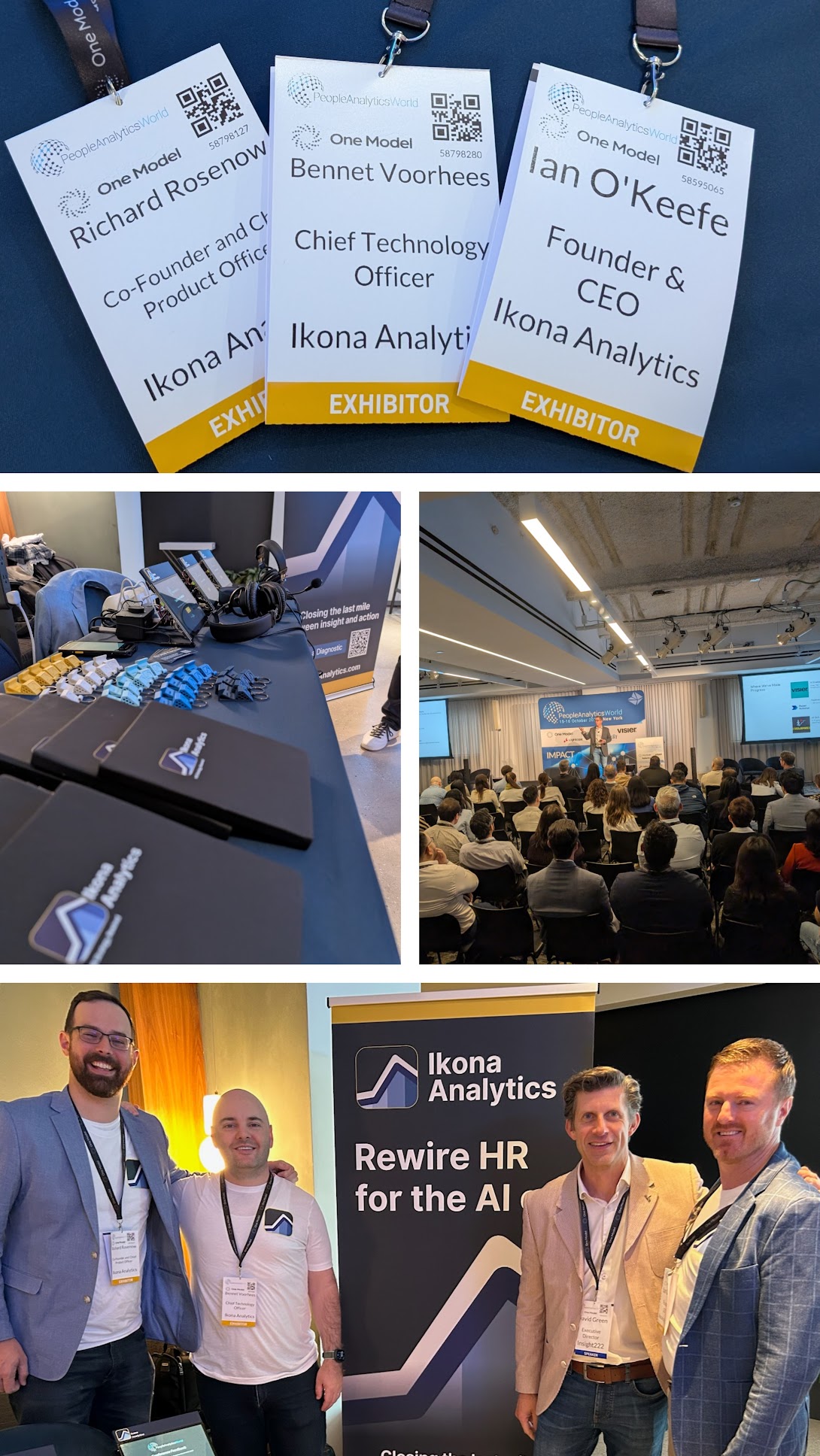
Thank you, Ikona Interviewer! I'm Richard Rosenow, Chief Product Officer at Ikona Analytics. Reading your analysis (or hearing it in my own voice) is a fascinating experience to say the least. It’s like studying a detailed architectural blueprint of the conference. Every connection, every theme, and every structural element is mapped with precision. The Interviewer did an incredible job capturing what was said. My goal now is to walk us through the building and to add the color, the texture, and the lived-in experience of being on the conference floor. I want to add some human context to your foundational data and explore why it matters.
The Vibe, The Voices, and Our Grand Experiment
The Interviewer's analysis of an action-oriented mindset perfectly captures the energy I felt on the conference floor. There was a palpable sense of purpose. The time for navel-gazing is over; the era of execution has begun. This wasn't a conference about admiring the problem; it was about sharing solutions. Most leaders I spoke with had been given the task to solve hard problems around AI and Analytics, and they were in the midst of solving them, eager to share insights and learn from others' progress.
This maturity was reflected in the speaker lineup, which was simply unreal this year. The presence of leaders like Ashish Parulekar, Global Head of Talent Acquisition Science and Analytics at Amazon; Stephanie Murphy, Vice President of People Experience at UnitedHealth Group; and Kristin Saboe, Head of Employee Voice at Google, signals a new phase for our field. These aren't niche roles at small tech companies; these are critical leadership positions at some of the world's largest and most complex organizations.
When Ashish Parulekar took the stage to dissect how Amazon embedded AI to reduce hiring costs by 90%, saving over a billion dollars annually, it was no longer a theoretical talk. It’s a case study in scaled, operational excellence. When Kristin Saboe, who leads the employee voice function for over 150,000 Googlers, discussed "listening as a product," it confirmed a major strategic shift in how we approach employee feedback. The caliber of these speakers and the substance of their work demonstrate that people analytics has graduated from a promising R&D function to an indispensable strategic lever.
"I Just Spoke with You": Psychological Safety and Trust by Design
Beyond the conference content, our experiment with the Ikona Interviewer provided its own set of profound observations. The engagement at our booth was exciting, and I'm deeply grateful to everyone who took the time to speak with the Interviewer. But the most surreal moments for me were the follow-up conversations.
One fun feature was the voice selection which included an easter egg of “Richard Rosenow’s voice” (a professional voice clone). Again and again, people would finish their session with the Interviewer, walk over to me, and say, "I just spoke with you." Not, "I just spoke with a bot," or "I just spoke with something that sounded like you." The phrasing was consistently, fascinatingly personal: "I just spoke with you".
We heard this sentiment echoed directly in the transcripts. One attendee's immediate reaction was an exclamation of surprise, recognizing that it was really my voice. At the end of another thoughtful interview, a participant remarked on how much they loved the interview method. A founder called it a "deeply engaging experience" while another called into question the future of surveys when tech like this starts to roll out.
This points to something crucial. A common barrier to the adoption of many AI tools is their impersonal, robotic nature, which creates friction and discourages candid interaction. Our experiment intentionally used a voice clone of a known and, I hope, trusted member of the people analytics community. The reactions suggest that this persona created a sense of familiarity and psychological safety. It transformed what could have been a cold, technological transaction into a warm, human-like dialogue.
This matters immensely. The great untapped opportunity in people analytics lies in understanding the nuance, context, and emotion of the human experience at work—the qualitative "why" behind the quantitative "what." To capture this data at scale, we need tools that people will trust and open up to. The feedback we received suggests that the persona of an AI is a critical design element. By creating an experience that feels human, we can dramatically increase the quality and depth of the qualitative data we collect. This experiment wasn't just a "parlor trick"; it was a proof of concept for a novel evolution in organizational listening. It demonstrates a path forward, leveraging a modern AI stack not just to collect data, but to build trust and capture the authentic human voice at scale. This is a new, more human-centric way of listening.
The Next Chapter of People Analytics is Being Written
Synthesizing the Interviewer's data with my own observations, a clear picture emerges. The people analytics field has reached an inflection point. The community is strong, the energy is focused on execution, and the core challenges have crystallized around three key areas: implementing AI responsibly, translating data into strategic influence, and proactively designing the future workforce.
At Ikona Analytics, we believe this next chapter will be defined by our ability to understand the human experience with more depth and nuance than ever before. The industry is asking for better ways to listen. Our experiment with the Ikona Interviewer at People Analytics World demonstrates a powerful path forward, a novel evolution in listening that leverages a modern AI stack to engage people in a highly contextualized way that feels natural and human. We are building the tools to answer that call.
If you'd like to learn more about where we're going with Voice AI Ikona Interviewer, reach out to us here at Ikona Analytics (Richard, Bennet, and Ian) to get a demo and learn more.
Be on the Lookout for more from Tucana!
Finally, a special thank you is owed to Barry Swales and the entire Tucana team. They once again curated an event that was more than just a conference; it was the essential gathering point for the entire people analytics community. The quality of the speakers and the intense focus on execution, as captured by both our AI and my own experience, set a new standard for the industry. If you are a leader in this field, the insights shared and connections made at People Analytics World are simply indispensable. We at Ikona are already looking forward to the next one, do not miss it.
https://peopleanalyticsworld.com/
See you next time!
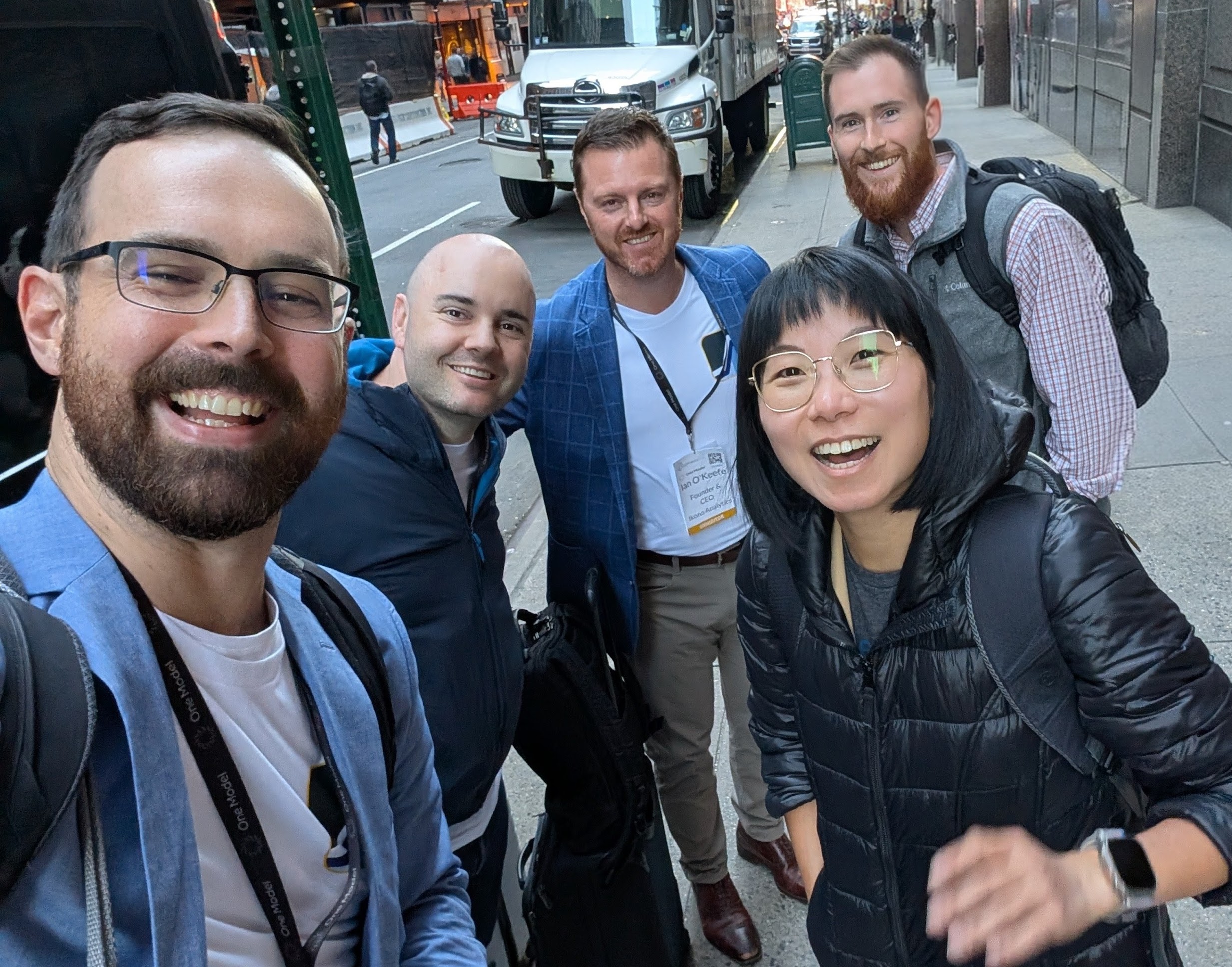
.png)
